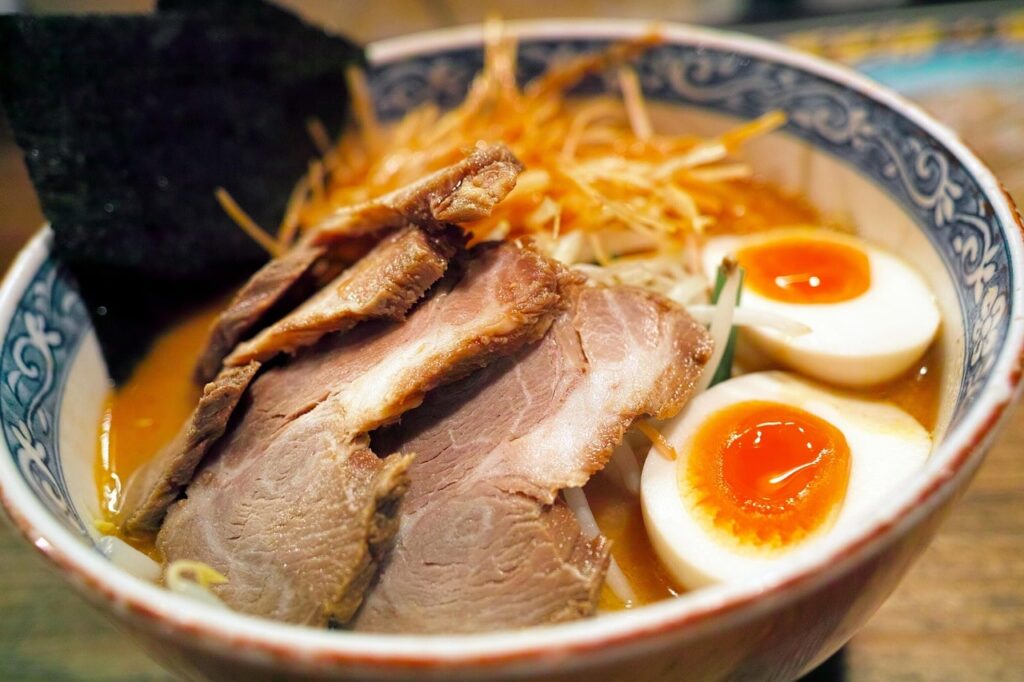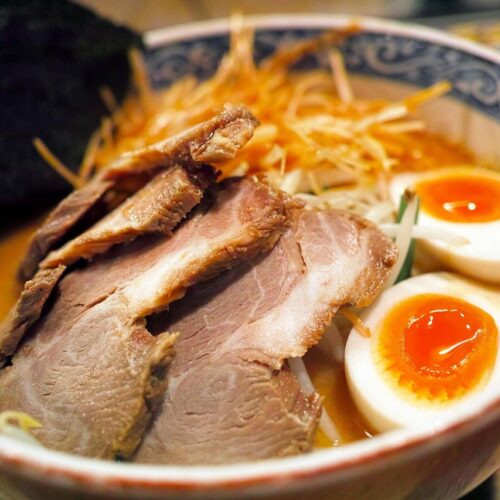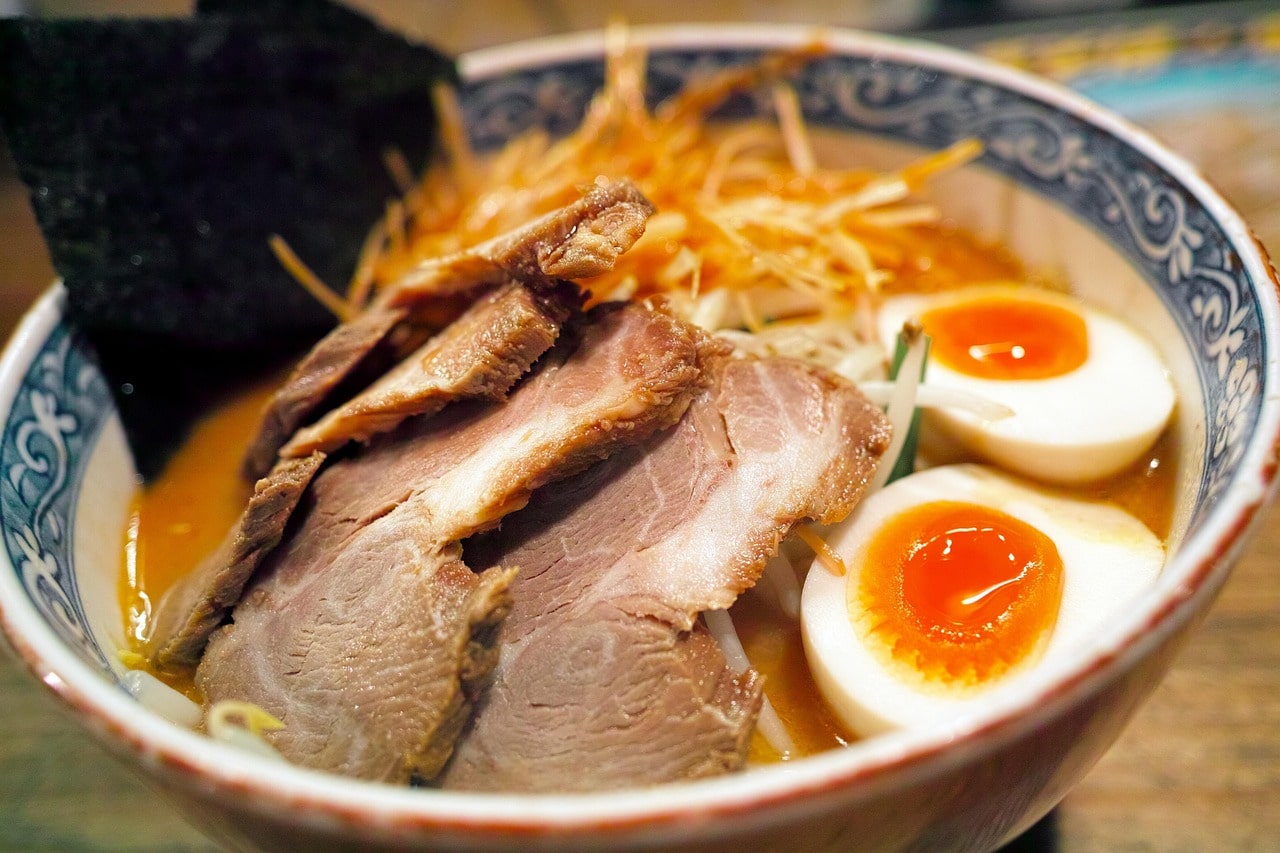Easy homemade ramen recipe with step-by-step instructions, health benefits, cooking tips, and FAQs for the perfect Japanese noodle soup.

Ratings 05

What Is Ramen?
Made with wheat-based noodles and served in a flavorful broth. Ramen is also is yet another form of Japanese noodle soup generally ready with green onions, sliced pork (chashu), seaweed, soft-boiled eggs, and vegetables.
Notwithstanding its Chinese ancestry, it became a mainstay of Japanese food and developed into a number of regional variants, like Tokyo’s shoyu ramen, Kyushu’s tonkotsu ramen, and Hokkaido’s miso ramen.
The essential components of ramen are:
- Wheat noodles, thin as well as springy.
- This same broth can be decided to be made with soy (shoyu), miso, salt, or pork bone fragments (tonkotsu).
- Eggs, slices of pork, vegetables, seaweed, corn, bamboo shoots, and more seem to be instances of toppings.
It’s become a global comfort food, from quick instant ramen packs to lush gourmet bowls served in specialty restaurants.
Health Benefits Of Ramen
01. Rich In Energy
- Ramen noodles provide carbohydrates, giving a quick energy boost.
02. Protein-Packed (With Toppings)
- Ramen has become a good source of protein, which is really necessary for strength and muscle repair, once eggs, pork, chicken, or tofu are added.
03. Vegetables Provide A Nutrient Boost
- Ramen offers iron, calcium, and magnesium, as well as vitamins A, C, and K, when it is loaded with seaweed, bok choy, spinach, corn, and mushrooms.
04. Amino Acids And Collagen (From Bone Broth)
- Traditional broths, especially tonkotsu (pork bone broth), contain collagen and amino acids, which promote the health of the skin, joint capsules, and digestive tract.
05. Warmth & Hydration
- When you’re sick or it’s cold outdoors, the soup base’s fluids and electrolytes can help improve your mood.
06. Things To Watch Out For
- Instant ramen is often high in sodium and may contain preservatives. Ingesting it too commonly can end up causing blood pressure to increase.
- Deep-fried instant noodles are higher in unhealthy fats.
- Cos of one‘s rich toppings and fatty broths, some restaurant ramen bowls are high-calorie.
07. Healthy Suggestions:
- Use low-sodium soup in the end.
- Add more vegetables.
- Choose lean proteins like chicken, tofu, or seafood.
- Save your instant ramen for important events.
Tips For Making Ramen
01. Choose The Right Broth
- The broth is the soul of ramen. End up making your base of vegetable stock, pork, or chicken.Add soy sauce, miso, or dashi for Japanese cuisine flavor.
02. Don’t Overcook The Noodles
- Cook ramen noodles just until slightly chewy (“al dente”). They will continue to soften in the hot broth.
03. Utilize Fragrances To Enhance Taste
- Sauté the garlic, ginger, and green onions before adding the same broth. This enhances the depth and scent.
04. Layer The Toppings Carefully.
- Corn, nori (seaweed), bok choy, mushrooms, sliced pork (chashu), and soft-boiled eggs are typical toppings. Add them last to keep them attractive and fresh.
05. Keep The Saltiness In Balance.
- Ramen may become overly salty, especially if combined with miso or soy sauce. Taste the broth and make any necessary adjustments before serving.
06. Add A Small Amount Of Umami
- A tablespoon of miso, a dash of soy sauce, or a dusting of bonito flakes or dashi powder could all enhance the umami flavor.
07. Finally, Apply Oils.
- Finally, a final drizzle of sesame, chili, or garlic oil adds richness and aroma.
08. Customize Your Bowl
- Depending on your mood, you could indeed make ramen spicy, creamy, light, or hearty.
FAQ Ramen
01. What Is Used To Make Ramen?
Ramen is generally made with wheat noodles in a tasty broth that has added vegetables, eggs, pork, seaweed, and mushrooms.
02. Can You Eat Ramen?
Instant ramen is commonly low in nutrients and high in sodium, but homemade or restaurant ramen made with fresh ingredients can be nutritionally. Balance it with vegetables and lean proteins to make it healthier.
03. Which kinds Of Ramen Are There?
- Shoyu made with soy sauce is transparent, salty, and savory.
- Rich, filling, and just a touch creamy is miso, which is made from fermented soybean paste.
- Shio made with salt appears to be light and sensitive.
- Tonkotsu made from pork bones appears to be thick, creamy, and rich.
04. Is It Possible To Make Vegetarian Or Vegan Ramen?
Likewise! End up making use of miso, soy sauce, vegetable broth, and plant-based garnishes, including such as corn, spinach, mushrooms, and tofu.
05. How Are Ajitsuke Tamago (Ramen Eggs) Prepared?
After gently poaching the eggs for 6–7 minutes, marinate them for a few hours or overnight in a combination of soy sauce, mirin, and water.
06. Are Ramen And Instant Noodles Interchangeable?
Not absolutely true. Instant noodles are a quick version of ramen but lack the depth of flavor found in authentic Japanese ramen made with fresh broth and toppings.
07. Can Leftover Ramen Be kept In Storage?
It’s best to store the broth and noodles separately. Noodles left in broth will become soggy.
08. How Can I Make Ramen Less Salty?
If using instant noodles, use low-sodium broth, dilute with water, and therefore do not add the a whole seasoning packet.

Ramen
Ingredients
- 4 cups chicken or vegetable broth
- 2 packs ramen noodles (discard seasoning packets if using instant)
- 2 garlic cloves, minced
- 1-inch piece of ginger, grated
- 2 tbsp soy sauce
- 1 tbsp miso paste (optional, for richness)
- 1 tsp sesame oil
- 1 cup mushrooms, sliced
- 1 cup bok choy or spinach
- 2 boiled eggs, halved (soft or hard as you prefer)
- 2 green onions, sliced
- Chili flakes or sriracha (optional, for spice)
Instructions
Prepare Broth:
- In a pot, heat sesame oil over medium heat. Add garlic and ginger, sauté until fragrant (1–2 minutes).
Simmer Base:
- Pour in the broth, soy sauce, and miso paste. Bring to a gentle simmer for 5–7 minutes.
Cook Noodles:
- Add ramen noodles and cook according to package directions (usually 3–4 minutes).
Add Vegetables:
- Stir in mushrooms and bok choy/spinach. Cook until just tender.
Assemble Bowls:
- Divide noodles and broth into bowls.
Top It Off:
- Add boiled egg halves, sprinkle with green onions, and finish with chili flakes or sriracha if desired.
-
Ramen
Easy homemade ramen recipe with step-by-step instructions, health benefits, cooking tips, and FAQs for the perfect Japanese noodle soup. Ratings 05 What Is Ramen? Made with wheat-based noodles and served in a flavorful broth. Ramen is also is yet another form of Japanese noodle soup generally ready with green onions, sliced pork (chashu), seaweed, soft-boiled…


Leave a Comment